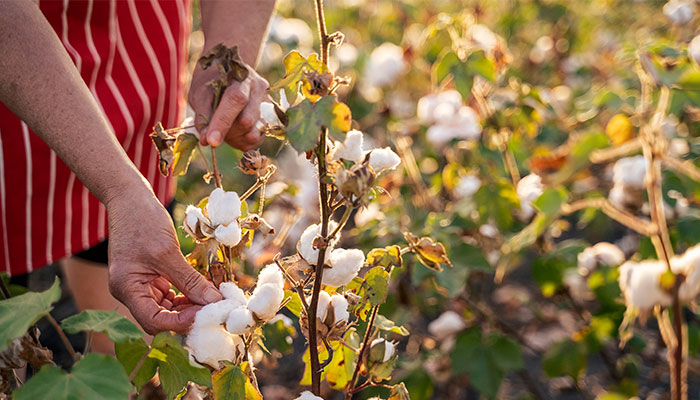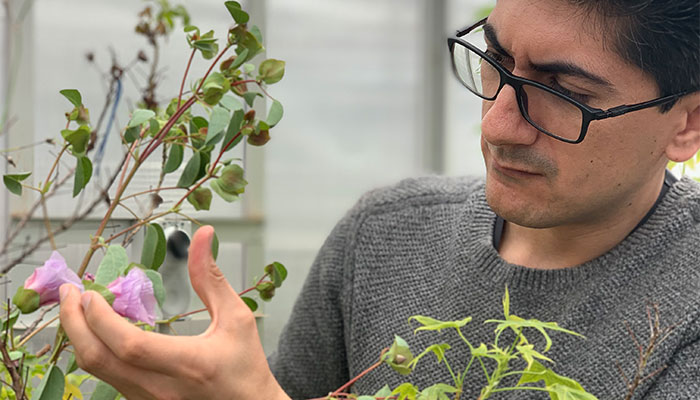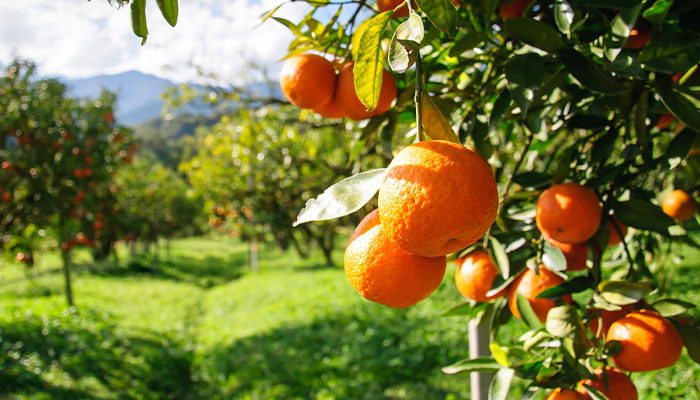As climate change intensifies, the very shirts on our backs are at risk as heat damage to pollen raises the prospect of catastrophic cotton crop failures.

Rising risk: A heat wave at the wrong time could lead to a massive wipe-out of cotton crops, says Professor Atwell.
Experiments conducted in the Atwell Lab at Macquarie University’s Department of Biological Sciences showed that cotton pollen grains exposed during their formation to temperatures above 36 degrees lost their capacity to fertilise and produce their precious lint.
“The heat damage to plants is very specific to pollen grains (the male cell line) and cotton is no exception, with the lint-filled bolls failing to form after a one- or two-day heatwave at the vital stage in pollen formation,” says plant physiologist Professor Brian Atwell.
“If we were to get an extended run of 40-degree days about a fortnight before anthesis – the moment the pollen fertilises the ovary – then we could have a major wipe-out.”
There are lots of examples of crops being essentially rendered sterile because of frost events but there is less knowledge about how heatwaves affect pollen.
The Lab has mapped the thousands of proteins found in mature cotton pollen after brief heatwaves, opening the way for the targeting of individual genes and modifying pollen to develop more heat-resistant cotton cultivars. Atwell’s group also applies proteomic analysis to the wild relatives of modern crop species, exploiting the rich genetic resources that have evolved in the harsh and hot conditions of northern Australia.
“We chose cotton because in the theme of everything we do at the Lab, we are interested in agricultural plants and their closely related wild Australian ‘relatives’” explains Atwell, whose previous discovery of a heat-resistant protein in wild rice is now in the development phase in genetically engineered wheat.
“We focussed on pollen because it has long been known that pollen cells are highly susceptible to extremes of temperature, just as sperm cells are in mammals.
“There are lots of examples of crops being essentially rendered sterile because of frost events but there is less knowledge about how heatwaves affect pollen.”

Up close: PhD student Farhad Masoomi-Aladizgeh inspects cotton flowers in the Atwell Lab ... through painstaking work, almost 1000 proteins were identified in cotton pollen.
Dr Ullah Najeeb, a former PhD student working in the Macquarie Plant Growth Facility, grew commercial cotton (Gossypium hirsutum), a species that comprises 90 per cent of world cotton production, before exposing them to daily maximum temperatures of up to 40 degrees for just five days at precisely targeted stages of pollen formation.
Long and painstaking work on individual pollen cells collected from cotton flowers by current PhD student Farhad Masoomi-Aladizgeh, in collaboration with Macquarie’s Australian Proteome Analysis Facility, identified almost 1000 proteins in a cotton pollen.
- Facebook is selling our data: are there laws to protect it?
- Scam slam: how to keep identity thieves at bay
Fewer than 10 per cent of these proteins were strongly associated with heat stress, giving researchers a deeper insight into precisely how and when heat damages the pollen. From these protein identities, genes can be identified.
“Our data on the proteins that were found in cotton pollen will provide new molecular tools for the crops of the 21st century,” Atwell says.
The research findings are published in a Special Issue on effects of heat on plants in the journal Plant, Cell & Environment.
Cotton’s crucial world role
Atwell says heat tolerance is arguably an aspect of climate change that is least addressed in plant biology.

Global staple: Cotton produced annually in Australia alone is enough to clothe 500 million people, according to Cotton Australia.
“We think a lot about drought, sea level rise, and what rising CO2 levels are doing to photosynthesis but heat tolerance is really important because we get these massive and unpredictable heatwaves” he says.
Pakistan, India, Egypt and the US are all major cotton producers and exporters, as well as Australia which, according to the industry’s’ peak body Cotton Australia, annually grows enough cotton to clothe 500 million people.
In addition to clothing, cotton lint is used in homewares and industrial products, while cotton seed is used as stock feed and to make oil, in turn used for a range of purposes from cooking to production of soap, cosmetics and pharmaceuticals.
But heat stress on cotton, which is a self-pollinating species, has begun to reveal itself, Atwell says. Agronomists in the field are reporting increased problems of extreme heat events. In the United States, field research discovered a 10 per cent decrease in lint yield for every 1 degree rise in daily temperature.
Reducing reliance on river water
Heat resistance becomes even more key to cotton’s future as the industry seeks to reduce its heavy reliance on river water and instead grow the crop in dryland conditions.
“Cotton is traditionally an irrigated warm subtropical crop, which is why growing takes place along major rivers like the Nile, the Mississippi and the Punjab,” Atwell says.
When it comes to crops, just like the Great Barrier Reef, it’s a race against time.
“But our river systems are ephemeral, hence there has been a shift to growing crops in more environmentally compatible conditions, maybe sacrificing some yield but with less stress on our water resources.
“There is very much a focus on securing yields under dryland conditions. The damaging effects caused by heatwaves are exacerbated when water is withheld and evaporative cooling slows down. In non-irrigated crops, the effects of heat will become much more acute.”
Against the clock
Atwell says the development of commercial cotton crops engineered with heat-resistant pollen could happen within a decade – or even sooner, depending on the urgency.
“It is like the COVID-19 vaccine story; the first port of call is to say it will take years, but then depending on factors such as technological advances, and also the immediacy of the problem – how desperate we are, basically – it can happen much faster,” he says.
“Extreme heat events would focus the mind of the world tremendously if, for example, suddenly cotton prices triple because of shortages due to environmental disasters.
“When it comes to crops, just like the Great Barrier Reef, it’s a race against time.”

Brian Atwell (pictured) is a Professor in the Department of Biological Sciences and heads the Molecular Plant Physiology Lab at Macquarie University.



